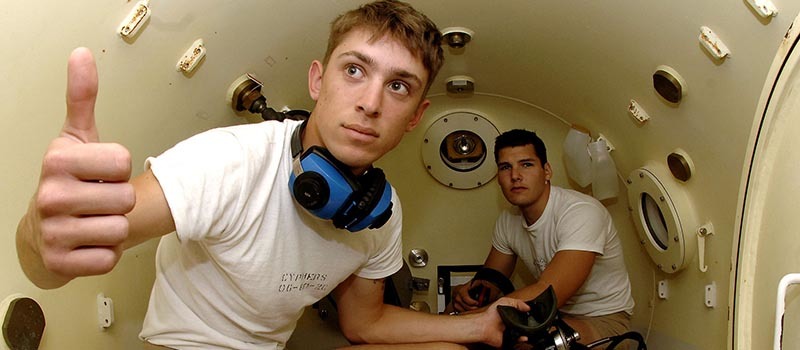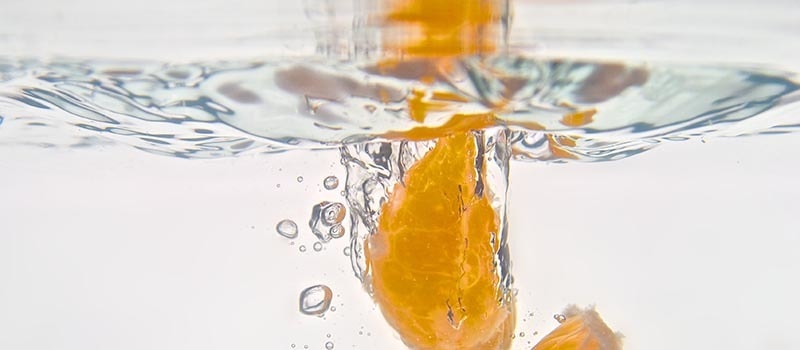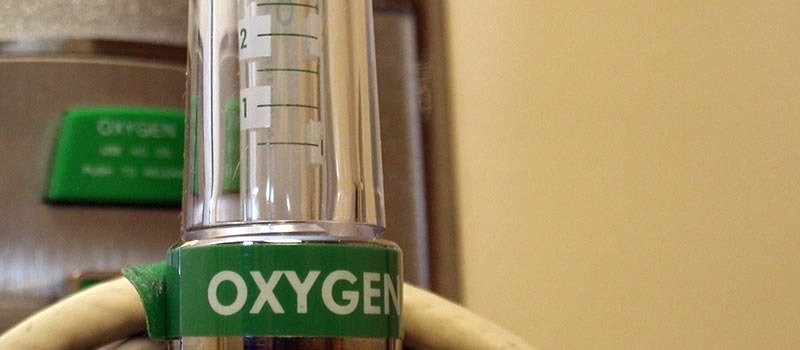Dive Medical Technician: Responsibilities, Salary & Certification
Last Updated on

Ever watched a game of NFL football? When all eleven players move strategically toward the touchdown zone, it’s a beautiful sight. The quarterback passes and hands off the football with ease, and when the ball makes it to the goal line, the crowds go wild. Cameras focus on the player holding the ball – usually a receiver or halfback.
But what about the linemen? These guys protected the quarterback all the way down, yet they receive little to no credit for their work. In international football (soccer), defenders serve in a similar, underappreciated role.
This is where you land as a Dive Medical Technician (DMT). Though safety should come first in all facets of professional diving, DMT’s have it stamped on their forehead. They are absolutely crucial to the success of a dive team, especially one that doesn’t have an understanding of medical equipment operation and knowledge of emergency diver care. In essence, they are the Emergency Medical Technicians (EMT) of the underwater world.
Dive Medical Technician Salary
How much money do Dive Medical Technicians earn?
There’s no set “salary” for this position, as it functions more as an extra card in your deck of professional skills as opposed to a standalone job. Think of it like advancing your level of education. But it doesn’t hurt anything, either – in fact, it may be the difference between earning a job or getting passed over by an employer. You also stand the chance of receiving a bump in pay if you’re the only certified DMT.
Recreational and commercial dive teams have DMT’s. Commercial divers primarily make use of them in offshore situations when they’re far away from hospitals and places for medical treatment. A Dive Medical Technician ensures the safety of the entire dive team, proactively identifying hazards, assessing divers’ needs and executing underwater emergency responses.
Primary Job Sites for a DMT
Where underwater welders and divers go, the DMT follows. Here’s a few examples.
- Oil rigs
- Underwater pipelines
- Dams
- Turbines
- Docks
These places don’t necessarily have to be hundreds of miles offshore for the DMT to tag along. Depending on national safety requirements and the proximity of the nearest hospitals, you may work as a DMT in many different environments.
Still, one of the most common work sites a DMT will go to is on an oil platform. These massive, floating cities may hold hundreds of workers on them, all in the process of pulling up black gold or natural gas from deep under the ocean waves. It’s also a flurry of activity among moving machinery, heavy metal, poisonous gases and pressurized chambers. In short, caution must be paid everywhere.
Health & Safety

In the process of working, underwater welders may run into a variety of dangers and hazards. Some are larger than others. Some hinder work. Others destroy the diver’s health, even to the point of death.
DMT’s must have a full, comprehensive knowledge of marine physical science, equipment operation and administration of diving medicine.
Physics
In liquids, the physical laws of sound, heat, light and other dynamics change. Water distorts and suppresses, and it holds unpredictable consequences for welder-divers. As a DMT, you’ll first focus on a few fundamental physics laws and theories in the classroom that will help you assess situations.
Transfer of Heat
Due to the massive thermal conductivity in water (about 20 times that of air), divers need much more insulation in chillier environments. Water’s also close to 800 times more dense, and this will directly affect the buoyancy of ROV’s, divers and their equipment. Archimedes, a Greek math whiz, developed this principle regarding the floating ability of objects.
Light Reflection & Absorption
Because of the density of water, light travels through water slower than on the surface. Water scatters light quicker causing less visibility faster below the surface. Even in clear water, specific color spectrums (like red) will be absorbed 15 – 20 feet down. Refraction in water magnifies objects, making that pipeline appear a few feet closer than it is.
Viscosity Resistance
Water has a “thickness” to it, and it puts more resistance on your limbs than if you were walking through air. The viscosity of water is about 100 more than air, give or take.
Sound Speed
In many ways, water slows down or completely stops things due to its density. Sound waves react differently, though. Density affects the elasticity of materials, and the greater density, the higher elasticity they have. Water is denser than air…therefore sound travels farther through it. Also, the lower the water temperature, the more easily sound travels.
Pressure Pounds
The most popular (probably least understood) aspect of underwater physics. With the higher density of water (compared to air), it also exerts more pressure – about 64 pounds per cubic foot. As pressure increases, your body will work harder to breathe until it you adapt to the pressure, since it’s coming in from all sides. In addition, water is almost completely incompressible, opposed to a gas.
Equipment Safety
Before even jumping in the water, underwater welders must carry the right equipment with them to accomplish their project. Though each underwater welder is responsible for their own equipment, DMT’s may check it over to ensure equipment has been properly maintained and will function at the depth that the divers are going to.
Most importantly, DMT’s must understand the repercussions and emergency procedures due to equipment malfunctions and accidents. Here are a few possibilities:
Diving Suit Tears
In cold water, this can result in extreme heat loss for underwater welders and will quickly lead to hypothermia. If they have an open wound in that area, the loss of blood will further speed up the process.
Explosions or Falling Objects
A pipeline bursts, or a boat anchor drops unexpectedly. In these situations, a welder-diver may suffer internal bleeding, fractures, broken bones, ear and eye damage.
Exposed Electric Conductors
Usually this means “hot” wires, but not always. If the electricity from equipment isn’t somehow grounded away from the diver, it may electrocute them and cause major damage to the central nervous system.
Cutoff Air Hoses
Underwater welders usually have a backup air tank for emergencies if their air supply is somehow cut off. However, if they can’t surface in time, lack of oxygen may cause brain hypoxia, carbon dioxide poisoning, low blood pressure or eventually drowning.
Hyperbaric Chamber Incorrect Pressures
Welder-divers’ bodies are extremely sensitive to the changing of pressure and are slow to adapt on the way back to the surface. Sometimes, saturation divers will spend weeks inside hyperbaric chambers depressurizing (or longer if they were brought to the surface in an emergency situation). Therefore, it’s crucial for DMT’s to closely monitor each diver’s vitals and the overall levels of the hyperbaric chamber.
One misstep may have long-term health consequences.
Medical Health Problems Treated by a Dive Medical Technician

Ever taken a dive fitness test? The test was probably administered and graded by a certified DMT. They’re trained to measure the health and symptoms of the human body from the standpoint of a marine environment.
In emergency situations, they function as the “middle man” between a hospital and the scene of the injury, like an ambulance. They use all available treatments and equipment available to them. Their equipment isn’t always top-of-the-line, since they don’t have access to a nearby hospital. Still, you can count on DMT’s to treat you with care and patience.
The Bends (Decompression sickness) & Narcosis
Dissolved gases make their way under the skin and into the blood stream, causing paralysis, joint issues and other issues. Nitrogen narcosis is a related incident that may affect the nerves, heart and other parts of the system. It can create partial or complete loss of consciousness, similar to have too many shots to drink.
Oxygen Poisoning
Too much oxygen can be a bad thing, killing the cells and destroying the antioxidants and other immune measures the body takes. It can create uncontrollable, violent bodily movements that are similar to the effects of seizures. Similar symptoms can arise when divers inhale a large portion of helium; this gas helps offset other harmful issues related to saturation diving. However, depending on the underwater welder, high helium intake can also create a high pressure nervous system.
Sinus, Ear, Throat & Mouth Injuries
All of these body parts appear more “sensitive” due to the dependency on pressure to function correctly. Infections, ear drum bursts, toothaches and other health problems may arise during or after the dive. Each one must be handled individually take all environmental factors into account.
Treatment: Therapy & Correction
To treat the root of underwater welder health issues, a Dive Medical Technician turns to certain forms of specialized therapy and more general, universal procedures.
Compression Therapy
During intensive saturation diving or emergency evacuation, welder-divers must be slowly introduced back to a the regular, pressurized environment. Enter compression therapy.
Coming back to the surface, underwater welders may be taken and sealed inside a hyperbaric chamber for a period of time to ensure the healthiest recovery possible. A DMT will assess the oxygen, and carbon dioxide levels of the person. They’ll analyze their breathing, heart rate and blood pressure. The hydrogen bubbles that sometime form inside a diver when they surface are extremely hard to detect, so DMT’s want to make sure these are completely gone.
Oxygen Therapy
Providing extra oxygen can give blood cells a “boost” and help the immune system heal quicker. It gives the lungs extra breathing power so they don’t have to work so hard. This may also be used in combination with compression therapy.
Everything Else
As we know, the human body is extremely complicated and there’s any number of health challenges a DMT may have to overcome: Stitching an open wound, setting a broken bone, resuscitation, analyzing sinuses. The list goes on. A DMT must have at least a basic foundation of each of these procedures in order to stop infections, blood loss and other health ramifications.
Diving Medical Technician Certification
So what’s next?
Working toward certification as a DMT will provide you with the knowledge and allow you to experience (at least partially) the life of someone in this profession. Here’s the steps you need to take:
1. Locate a Training Facility
Find a training body (usually a dive school) that will provide with a complete, certified program. Make sure they are credentialed through one or more recognized diving organizations like the IMCA. The National Board of Diving & Hyperbaric Medical Technology has a great course and it’s available internationally. Here are the associated training areas for the NBDHMT program.
Often, the DMT training course will be an add-on to a larger, already existing course that your training body offers. Therefore, you should consider completing along with receiving full commercial diving certification if you haven’t done so yet.
2. Stay the Course: Training
Most places have a similar setup for their Dive Medical Technician program, though equipment quality may range such as the hyperbaric chamber, computer technology and software. The course usually lasts around 2 weeks with about 30 – 60 hours of combined classroom and field training.
3. Test
Finally, you’re ready to take your exam to become certified. Locate your testing site first – it may be different from your training site. Confirm the date and time of your exam. Once you’re tested, look in the mirror and high-five yourself: You’re now a registered Dive Medical Technician!
